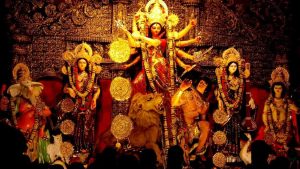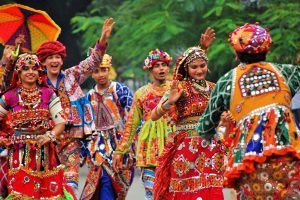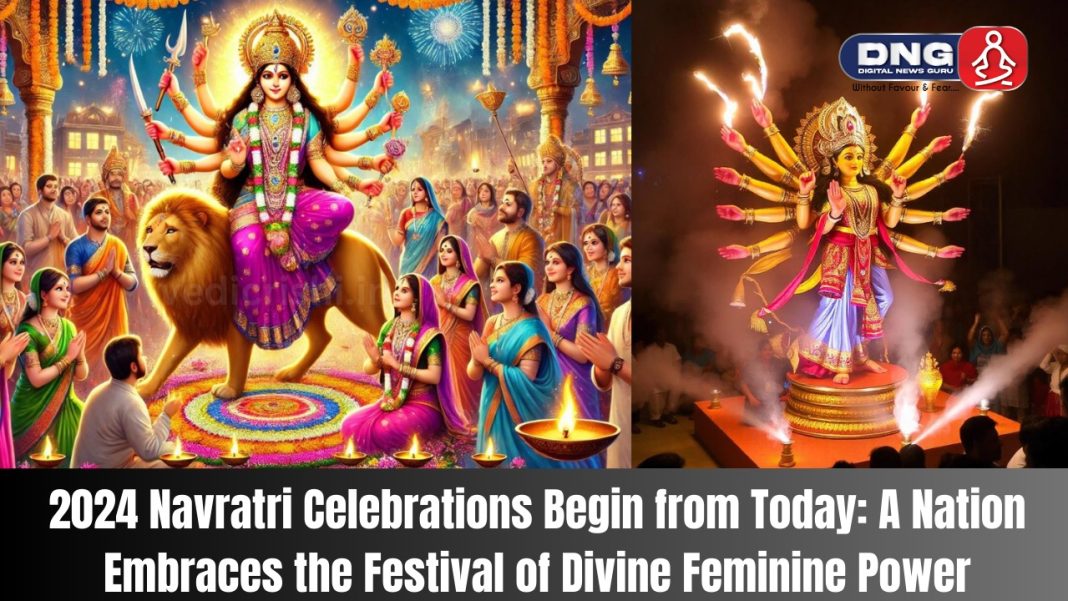DIGITAL NEWS GURU RELIGIOUS DESK:
2024 Navratri Celebrations Begin from Today: A Nation Embraces the Festival of Divine Feminine Power
The much-anticipated Navratri festival of 2024 begins today, October 3, marking nine days of worship, fasting, and grand celebrations across India.
Navratri, which translates to “nine nights,” is one of the most significant Hindu festivals and is dedicated to the worship of Goddess Durga and her various manifestations. The festival embodies the victory of good over evil and the power of the divine feminine.
As the celebrations begin, communities across the country are preparing for vibrant cultural displays, devotional practices, and large-scale public gatherings. Each region of India adds its own unique flavor to the Navratri festivities, making this festival not just a spiritual event, but also a cultural and social extravaganza.
Spiritual Significance of Navratri

The core of Navratri celebrations revolves around the worship of Goddess Durga. Over the nine days, devotees honor her nine avatars, each representing different virtues, powers, and lessons. The festival is divided into three parts, with the first three days dedicated to Durga, the goddess of strength and protection. The next three days are devoted to Lakshmi, the goddess of wealth, and the final three to Saraswati, the goddess of wisdom and knowledge. This progression signifies a path from physical purification to spiritual enlightenment.
The festival culminates on the tenth day, known as Vijayadashami or Dussehra, which marks the triumph of good over evil. In many parts of India, this day commemorates the victory of Lord Rama over Ravana, while in others, it celebrates Durga’s defeat of the demon Mahishasura. Both narratives reinforce the festival’s central message: that righteousness and devotion will always prevail over negative forces.
Regional Variations in Navratri Celebrations

Navratri is celebrated with immense fervor across the country, but the manner of celebration varies widely depending on the region, each offering a unique set of traditions, rituals, and festivities.
In West Bengal, the festival is synonymous with Durga Puja, a grand celebration where elaborately decorated pandals (temporary structures) house magnificent idols of Goddess Durga. The pandals often become showcases of artistic talent, with intricate themes that blend mythology, social messages, and contemporary culture. The streets of Kolkata, in particular, are known for their dazzling lights, decorations, and round-the-clock cultural programs. Durga Puja is a time for community bonding, as families come together to offer prayers, enjoy traditional feasts, and participate in rituals such as the Sindoor Khela, where married women apply vermilion to each other as part of the celebrations.

In Gujarat, Navratri is marked by the energetic and vibrant Garba and Dandiya Raas dances. People of all ages dress in colorful traditional attire and gather in large open spaces to dance around an idol of Goddess Durga. Garba, which involves circular movements, is a devotional dance performed in honor of the goddess, while Dandiya Raas, played with sticks, is a high-energy celebration. The state comes alive with music and dance every night of Navratri, creating an atmosphere of joy and unity. Gujarat’s Navratri celebrations are perhaps the most visually striking, with thousands of people participating in nightly dance events.
In Maharashtra, Navratri is a time for both religious observance and social celebration. Temples are decorated, and devotees observe fasts, offer special prayers, and attend aarti (devotional songs). Mumbai and Pune, being cosmopolitan cities, host a blend of Garba, Dandiya, and Durga Puja events, reflecting a fusion of North and East Indian traditions. The state also sees large community gatherings, where people come together for cultural performances, music, and dance.
In North India, particularly in states like Uttar Pradesh, Bihar, and Delhi, Navratri is associated with Ramlila performances, which dramatize the story of Lord Rama’s life, leading up to his victory over Ravana. These performances, often held in open grounds, draw large crowds and are followed by the symbolic burning of Ravana’s effigy on Dussehra, signifying the victory of good over evil.
The southern states of Tamil Nadu, Karnataka, and Andhra Pradesh celebrate Navratri with the unique tradition of Bommai Golu (also known as Kolu or Golu). This involves creating elaborate displays of dolls and figurines, which represent various deities, animals, and mythological scenes. The dolls are arranged on stepped platforms in homes and temples, and the display serves as a reminder of various religious stories. In addition to prayers and offerings, music and dance performances are also central to the celebration, especially the Carnatic concerts in temples and cultural venues.
YOU MAY ALSO READ: Gandhi Jayanti 2024: 10 Quotes by Mahatma Gandhi to Guide Your Journey Toward Change








